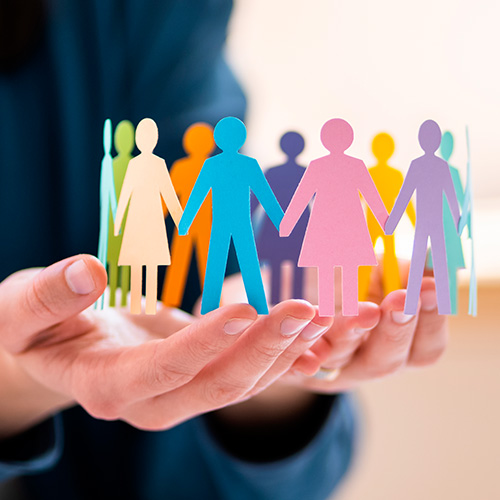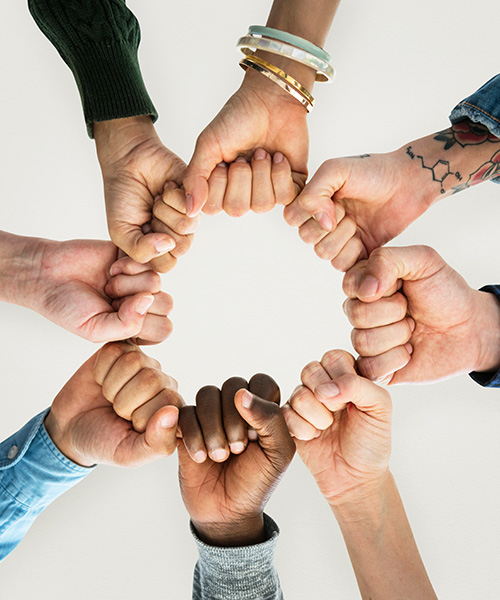
What is the difference between inclusion and integration?
What is the difference between inclusion and integration?
In search of a society for all
In search of a society for all
When we speak about "inclusion" and "social integration," it's not always clear what the difference is. However, both concepts differ in the way they approach the way people participate in society. Both are used in the context of diversity and equal opportunities, but their approach varies. Let's look at the difference between them.
What is social integration?
What is social integration?
Social integration focuses on the adaptation of people with special needs (e.g., disabilities) to a pre-existing system, whether educational, employment, etc.
Specific opportunities and spaces are created for them, to enable them to develop their full potential and achieve social well-being.
For example, special education groups within the education system must be mentioned, which provide classes exclusively for students with disabilities, as well as the assignment of specific classes or designated areas for employees with any disabilities in companies. The origin of this name dates back to the 1920s and was driven by the sociologist Émile Durkheim.
What is social inclusion?
What is social inclusion?
What is the difference between integration and inclusion?
What is the difference between integration and inclusion?
Although the aim of both approaches is to solve the difficulties related to the social exclusion of vulnerable groups, while promoting the equal opportunities and rights of all people, the way they approach this issue is significantly different. There are differences between inclusion and integration that we must understand:
Examples of integration and inclusion
Examples of integration and inclusion
Inclusion and integration are two fundamental but distinct approaches to managing diversity within organizations. This distinction is key to understanding and strengthening business practices aimed at building more diverse, equitable, and innovative organizations. Here are some examples:
Examples of social integration in the company
- Job placement programs for groups at risk of exclusion: Many companies develop initiatives to incorporate migrants, refugees, or people with disabilities, providing them with training and support during their adaptation to the work environment.
- Adoption of equal opportunity policies: Ensure that all employees, regardless of their origin, gender, or status, have access to the same training, promotion, and benefits processes, promoting equity in professional development.
- Intercultural awareness and coexistence activities: Organize workshops or events that promote understanding and coexistence among employees of different cultures or backgrounds, in order to facilitate adaptation and mutual acceptance.
Examples of social inclusion in the company
- Design of accessible and adapted work environments: Implement reasonable adjustments in facilities and tools to ensure that employees with different abilities can fully participate in working life.
- Diversity and inclusion policies integrated into corporate culture: Beyond hiring, we foster an environment where all voices are heard and valued, ensuring that diversity is reflected in decision-making and leadership opportunities.
- Ongoing training in inclusive leadership and diversity management: Empowering management teams and employees to identify and overcome unconscious biases, thus fostering an organizational climate where everyone feels respected and able to contribute fully.
Repsol and social integration
Repsol and social integration
- We are committed to gender equality through mentoring programs, unconscious bias training, design of female talent maps in order to enhance the leadership of women, and the development of our equal opportunities plan to improve the labor situation of women. Our aim is to reach 35% of women in leadership positions.
- With regards to people with disabilities, we have a total of 486 employees in the different countries where we operate. The Diverse Talent project addresses advances in prevention and accessibility, in addition to contemplating the evolution of our corporate culture based on our values as a company. Identifying talent, improving the quality of life of all people, facilitating integration, and eliminating the barriers that hinder it are just some of the aspects that reflect our commitment to equal opportunities.
- We also have specific programs that ensure the transmission of knowledge from the most-experienced employees to new hires, while we promote the so-called "professions of the future." Generational diversity enriches us as a company by making the most of the youngest talent but also the wisdom, experience, and professionalism of the most experienced.
- Another driver of growth and source of value for us as a company is cultural diversity. We have more than 24,000 employees representing 79 nationalities, which allows us to enjoy a perspective that is as plural as it is enriching.
- We are also committed to the LGBTI+ community, and we express our respect for all people regardless of their sexual orientation, identity, and gender expression. All our actions are based on the principle of equality and non-discrimination, which enables us to create a respectful environment to enhance talent. In this regard, it's worth mentioning the Proud at Repsol allies, who are a group of volunteers that work for the equality of the LGBTI+ community in the workplace, ensuring the well-being of people and equal opportunities in all the company's areas and locations. Repsol has also subscribed to the Standards of Conduct of non-discrimination against LGBTI people promoted by the United Nations and the Ministry of Exterior Affairs. Also, since 2019, it has been part of REDI, an association of businesses and professionals that advocates fostering an inclusive environment that values talent regardless of gender identity.
Join our team!
Launch your career with us and help us create the future of energy.
Emotional salary
Emotional salary
Types and examples of non-financial benefits that are increasingly being found in companies.

Women entrepreneurs
Discover the characteristics of women entrepreneurs.

